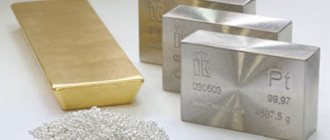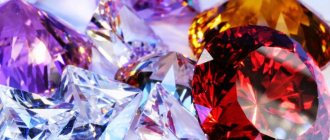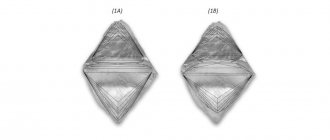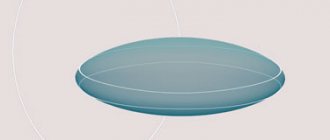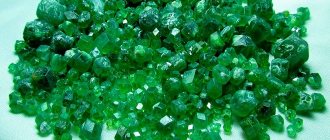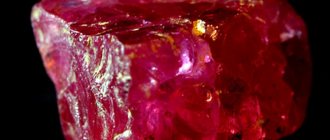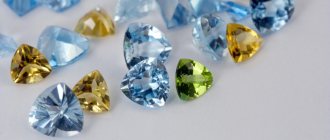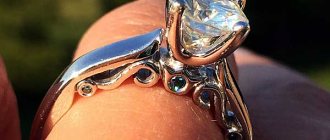Author: Dimon
11 February 2021 13:31
Community: Facts
Tags: jewelry interesting stones
12029
13
Today, about 200 varieties of natural precious stones are known in the world. Along with precious stones (natural diamonds, emeralds, rubies, sapphires and alexandrites, as well as natural pearls in raw (natural) and processed forms) there are many semi-precious stones, some of which are incredibly rare that their value exceeds many of the most valuable gemstones in the world.
0
See all photos in the gallery
Grandidierite
An amazingly beautiful mineral discovered in Madagascar was named after the island explorer Alfred Grandidier. The stones have a pronounced white-green-blue tricolor. The first sample of pure grandidierite was purchased for 29 thousand dollars. Today, the existence of 8 genuine minerals has been confirmed.
0
How to distinguish an original from a fake
Most gems are inexpensive stones, but they are also counterfeited. The main substitutes - plastic and glass - are even cheaper. They use special garnet glass of different colors and painted cubic zirconia. Sometimes jewelry includes both natural and artificial specimens.
To check, the stone is examined in the light with a magnifying glass. It’s easier to notice the catch if you know the characteristics of a particular variety of pomegranate. Although there are common signs:
- Usually the size of the jewelry is no larger than a coffee bean. But there are exceptions, for example, standard rhodolite is about 2 cm.
- Even high-quality natural stone has uneven color density; shades differ from different sides. Artificial - uniformly colored. The jewelry contains fake minerals that are suspiciously identical in size.
- A natural crystal has inclusions, while an artificial one is completely pure. If gas bubbles are seen inside, it is glass.
- The garnet gemstone has a dull shine, while synthetics shine.
- The play of light occurs inside a natural mineral. The rays penetrate there unevenly. The edges refract them. The fakes don't have this.
- Rare species are expensive and difficult to find. If a product is suspiciously cheap, this is a reason to think twice. For example, you are unlikely to find real greenish stones in a regular store.
- Garnet easily scratches glass and plastic. There should be no traces left on it.
- A real gem is magnetized. The experiment is carried out on electronic carat scales. The weight should decrease.
- You can check the authenticity by holding the stone in your hand for a couple of minutes. The real one should stay cool.
Majorite
Majorite is named after physicist Alan Major, a unique purple mineral also called purple garnet. Garnets acquire this color when exposed to enormous pressure. It was first discovered in Western Australia. The cost of the 4.2-carat mineral was $6.8 million.
0
Garnet purple
Violet garnet, or majorite, is another rare variety of garnet. The stone can safely be called a gift from heaven, since it was found in a meteorite that fell on Australian territory. It was in 1970 that a person first saw a rare stone, which, according to scientists, was formed under ultra-high pressure unthinkable for the Earth. The name of the stone was given in honor of the scientist Alan Major. In the 90s of the 20th century, several more similar minerals were found in Russia, the USA, France, Turkey and Madagascar. Perhaps, as other planets of the solar system and the Moon are explored, the stone will cease to be a great rarity, since there are also many fallen meteorites there. In the meantime, on our planet this stone costs more than $1 million per carat.
Red diamond (red diamond)
Among colored gems, the rarest is the red diamond, the average price for 1 carat of which reaches 1 million dollars. Natural color is purple-red. This color is given to such diamonds by constant deformations in the structure of the crystal lattice. The most beautiful stones are rated “fancy red.” The only active mine is the Argyle mine in Western Australia. There are about 50 red diamonds in the world.
0
Green pomegranate
Green garnet is a demantoid. The mineral is transparent, yellow-green or green in color, which is obtained due to the admixtures of titanium, chromium and iron. Demantoids mined in the Urals have byssolite inclusions called “horsetail”. These inclusions give the mineral additional decorative properties and give it an unusual appearance. Demantoids found in other deposits, in African countries, do not have such inclusions. In Russia, the first demantoid was discovered in 1874, not far from Yekaterinburg, on the Bobrovka River, so at first it had other names - Bobrovsky garnet, Ural chrysolite, Ural emerald. In the West it was called Siberian chrysolite. Then green pomegranate was found in Kamchatka and the Kola Peninsula. However, at the moment, Russian deposits have dried up; gem-quality demantoid is mined in Iran and Madagascar. The cost of green garnet on the modern market is about $2,000 per carat.
Red beryl
"Red beryl" or "red emerald" was first described in 1904 by the American mineralogist Bixby. Chemical analysis shows a connection with aquamarine and emerald, but red beryl is a very rare mineral. There are active deposits only in the USA. The extraction process is technologically very complex. The largest faceted mineral weighs no more than 10 carats.
0
Rare stones
Painite
In 2005, the Guinness Book of Records awarded painite the title of the world's rarest gemstone mineral. It was first discovered in Myanmar by British mineralogist Arthur Pyne in 1950. For many decades, there were only two discovered crystals of this mineral in the world. By 2005, about 25 had been found.
Today, painites are not as rare as they once were. According to the California Institute of Technology for Geological and Planetary Sciences, another deposit of this mineral has been discovered in Myanmar. In addition, two more large painite mining sites were found in the area of the Burmese city of Mogok. To date, about several thousand crystals of this stone have been found. And yet, it is still one of the rarest gems on Earth.
Tanzanite
Tanzanite is found in nature almost 1000 times less frequently than diamond. And this is natural, since there is only one place in the world where these stones can be found. They are mined in the foothills of Kilimanjaro, and the number of stones that go on sale is extremely limited. Like alexandrite, tanzanite has the property of changing its color depending on the orientation of the crystal and lighting conditions. But unlike alexandrite, tanzanite is characterized by trichroism. This means that it has three colors, not just one. The mineral changes color from blue to purple, and then to red. According to research, these color variations are largely caused by the presence of vanadium ions in the stone.
In its natural state, tanzanite is blue or purple with brown or yellow areas. Therefore, for jewelry purposes, all stones are exposed to high temperatures in order to get rid of yellow inclusions and give the crystal a uniform and rich blue-violet color.
Taaffeit
It was discovered by chance among cut gems. In 1945, Count Richard Taaffe noticed a stone among the faceted spinel crystals he had purchased that was slightly different in color from the rest. Taaffe sent it for examination to the laboratory of the London Chamber of Commerce and Industry for identification. The conclusion said that this was a new mineral, still unknown to mankind. Until this time, most taaffeites were mistaken for spinel.
Thus, taaffeite became the only stone that was discovered after it was processed. For many years afterwards, it was known in only a few examples, and is still one of the rarest gem crystals in the world.
Musgravit
It is this mineral, a direct “relative” of taaffeite, that is the rarest in the world. Currently, only 14 musgravites are registered in the world. This stone was first found in 1967 in the Musgrave Ranges of South Australia.
Later, individual crystals were found in Greenland, Madagascar, and Antarctica. But only those found in Australia are considered gem-quality stones.
Benitoite
This amazing blue stone was discovered, as its name suggests, at the mouth of the San Benito River in California
One of the most distinctive features of this stone is how amazing it looks under UV light. Under such lighting it fluoresces acid blue. The strange thing is that, although it was first described at the beginning of the twentieth century, its origin and the substances that give it its fluorescent properties are not yet fully understood.
Grandidierite
This bluish-green mineral is found almost exclusively in Madagascar, although the first, and apparently only, faceted specimen was found in Sri Lanka. Like alexandrite and tanzanite, grandidierite has the ability to pleochroate, and can change color from blue to green to white.
Poudretti
The first examples of poudrettite were found in the mid-1960s at the Poudrette Quarry in Quebec, but it was not recognized as a new type of mineral until 1987. Therefore, a detailed description of this gemstone was not compiled until 2003. According to some sources, this was done because few people have a chance of ever encountering powdertitis, and even more people have probably never even heard of it.
Jeremievit
First found in Siberia at the end of the 19th century. After this, several gem-quality crystals were discovered in Namibia. The largest faceted jeremiahite on Earth weighs only 60 carats (about 12 grams).
Red Beryl
Red beryl (also known as bixbite or “scarlet emerald”) was first described in 1904, and at that time, due to its fairly similar chemical composition, it was mistaken for the color variety of emerald or aquamarine.
Known deposits of this stone are limited to the US states of Utah and New Mexico, and their extraction is extremely difficult and therefore expensive. The weight of the largest cut stone to date is 10 carats.
Red diamond
Despite the fact that the diamond itself is not a rare stone, its color varieties are a less common phenomenon. And red diamonds are something incredibly exclusive.
This is the rarest type of diamond. And this fact is clearly confirmed by the fact that the largest red diamond found, Mussaif, weighs a little more than one gram or 5.11 carats.
Alexandrite
An amazing stone that can change its color was discovered in 1830 in the Urals in Russia and named after the Russian Tsar Alexander II. Alexandrite is a variety of chrysoberyl and appears blue-green in sunlight, but turns red-violet in incandescent light. The cost of this gem weighing up to 1 carat is $15,000, but a stone weighing more than one carat will cost $70,000 per carat.
0
Chemical and physical properties
Garnets belong to the class of natural silicates. Each grain is usually found separately, although there are also crystalline masses of stones (“kozinaki”).
Gems have a general formula that includes calcium, magnesium, iron, manganese, aluminum, chromium, titanium, vanadium, zirconium. Moreover, these elements easily replace each other.
As a result, each type of pomegranate has its own characteristics in its composition. Hence the differences in color and properties . For example, grossular will be more resistant to hydrochloric acid than pyrope.
General characteristics include:
- Glassy luster, sometimes close to diamond or the same.
- Resinous, greasy tint.
- Transparency of varying degrees.
- Powder - light shades.
- The color depends on the composition. Brown, brown and black shades are produced by iron. Red pomegranates are usually low in calcium. The green color of uvarovite is due to chromium.
- Natural density is 3.18-4.28. In andradite, with an increase in the proportion of iron oxide, the density increases.
- Hardness - 6-7.5 points.
- The fragments have sharp edges.
Musgravit
Musgravite is a rare stone, beryllium and magnesium oxide. It was first found in the Musgrave Valley in Australia in the middle of the last century. Then individual specimens began to be found in Tanzania, Greenland and Antarctica. The mineral can have different colors and shades, but most often it is green or purple. Over the years, people have found several stones of this type, so they are not cheap - up to 3 thousand dollars per carat of green musgravite, and about 6 thousand dollars per carat of purple stone, after cutting. But not all types of musgravite are suitable for jewelry production; there are also less valuable minerals of this type, suitable only for making souvenirs and facing tiles. The first specimen of interest to jewelers was found in 1993. There are currently only 14 real musgravites in the world, the largest of which weighs 5.93 carats.
Eremeevit
Eremeevite is an aluminum borate, a rare and expensive stone, first found in the Trans-Baikal Territory. The first specimen of a previously unseen stone was discovered in 1883. Due to the blue color of the crystals, the stone was first considered an aquamarine, but then it was studied in more detail and given a different name, after the Russian mineralogist Eremeev. Colorless or light yellow specimens were found later. Nowadays, there are only a few hundred copies of eremeevite that have been cut. Their cost reaches 1.5 thousand dollars per carat.
